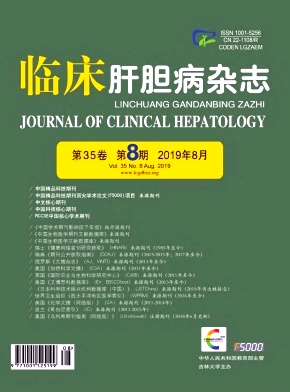|
[1] OSNA NA, DONOHUE TM Jr, KHARBANDA KK. Alcoholic liver disease:Pathogenesis and current management[J]. Alcohol Res, 2017, 38 (2) :147-161.
|
|
[2] VASSALLO GA, TARLI C, RANDO MM, et a. Liver transplantation in patients with alcoholic liver disease:A retrospective study[J]. Alcohol Alcohol, 2018, 53 (2) :151-156.
|
|
[3] National Workshop on Fatty Liver and Alcoholic Liver Disease, Chinese Society of Hepatology, Chinese Medical Association;Fatty Liver Expert Committee, Chinese Medical Doctor Association. Guidelines of prevention and treatment for alcoholic liver disease:A 2018 update[J]. J Clin Hepatol, 2018, 34 (5) :939-946. (in Chinese) 中华医学会肝病学分会脂肪肝和酒精性肝病学组, 中国医师协会脂肪性肝病专家委员会.酒精性肝病防治指南 (2018年更新版) [J].临床肝胆病杂志, 2018, 34 (5) :939-946.
|
|
[4] STICKEL F, DATZ C, HAMPE J, et al. Pathophysiology and management of alcoholic liver disease:Update 2016[J]. Gut Liver, 2017, 11 (2) :173-188.
|
|
[5] KOLIOS G, VALATAS V, KOUROUMALIS E. Role of Kupffer cells in the pathogenesis of liver disease[J]. World J Gastroenterol, 2006, 12 (46) :7413-7420.
|
|
[6] BALA S, CSAK T, KODYS K, et al. Alcohol-induced miR-155 and HDAC11 inhibit negative regulators of the TLR4 pathway and lead to increased LPS responsiveness of Kupffer cells in alcoholic liver disease[J]. J Leukoc Biol, 2017, 102 (2) :487-498.
|
|
[7] PARK JK, SHAO M, KIM MY, et al. An endoplasmic reticulum protein, Nogo-B, facilitates alcoholic liver disease through regulation of kupffer cell polarization[J]. Hepatology, 2017, 65 (5) :1720-1734.
|
|
[8] SORGI CA, ZARINI S, MARTIN SA, et al. Dormant 5-lipoxygenase in inflammatory macrophages is triggered by exogenous arachidonic acid[J]. Sci Rep, 2017, 7 (1) :10981.
|
|
[9] BRUNO F, ERRICO S, PACE S, et al. Structural insight into the optimization of ethyl 5-hydroxybenzo[g]indol-3-carboxylates and their bioisosteric analogues as 5-LO/m-PGES-1 dual inhibitors able to suppress inflammation[J]. Eur J Med Chem, 2018, 155:946-960.
|
|
[10] TITOS E, CLRIA J, PLANAGUMA, et al. Inhibition of 5-lipoxygenase-activating protein abrogates experimental liver injury:Role of Kupffer cells[J]. J Leukoc Biol, 2005, 78 (4) :871-878.
|
|
[11] LEO LM, ALMEIDA-CORRA S, CANETTI CA, et al. Agedependent relevance of endogenous 5-lipoxygenase derivatives in anxiety-like behavior in mice[J]. PLo S One, 2014, 9 (1) :e85009.
|
|
[12] SUMMA KC, VOIGT RM, FORSYTH CB, et al. Disruption of the circadian clock in mice increases intestinal permeability and promotes alcohol-induced hepatic pathology and inflammation[J]. PLo S One, 2013, 8 (6) :e67102.
|
|
[13] DESMET VJ, KNODELL RG, ISHAK KG, et al. Formulation and application of a numerical scoring system for assessing histological activity in asymptomatic chronic active hepatitis[Hepatology 1981; 1:431-435][J]. J Hepatol, 2003, 38 (4) :382-386.
|
|
[14] MASARONE M, ROSATO V, DALLIO M, et al. Epidemiology and natural history of alcoholic liver disease[J]. Rev Recent Clin Trials, 2016, 11 (3) :167-174.
|
|
[15] LOUVET A, MATHURIN P. Alcoholic liver disease:Mechanisms of injury and targeted treatment[J]. Nat Rev Gastroenterol Hepatol, 2015, 12 (4) :231-242.
|
|
[16] SZABO G, PETRASEK J. Gut-liver axis and sterile signals in the development of alcoholic liver disease[J]. Alcohol Alcohol, 2017, 52 (4) :414-424.
|
|
[17] LIN XX, CHEN D, ZHAO Q, et al. Genetic reasearch on the incidence of alcoholic liver disease[J]. Chin J Clin Pharmacol Ther, 2017, 22 (11) :1309-1314. (in Chinese) 林秀贤, 陈丹, 赵青, 等.影响酒精性肝病发病的遗传学研究进展[J].中国临床药理学与治疗学, 2017, 22 (11) :1309-1314.
|
|
[18] NADARAJAN K, BALARAM P, KHOO BY. MK886 inhibits the pioglitazone-induced anti-invasion of MDA-MB-231 cells is associated with PPARα/γ, FGF4 and 5LOX[J]. Cytotechnology, 2016, 68 (5) :1771-1787.
|
|
[19] DAGLAR GO, KAMA NA, ATLI M, et al. Effect of 5-lipoxygenase inhibition on Kupffer cell clearance capacity in obstructive jaundiced rats[J]. J Surg Res, 2001, 96 (2) :158-162.
|
|
[20] ZHOU H, YU M, ZHAO J, et al. IRAKM-Mincle axis links cell death to inflammation:Pathophysiological implications for chronic alcoholic liver disease[J]. Hepatology, 2016, 64 (6) :1978-1993.
|
|
[21] KOOP DR, KLOPFENSTEIN B, IIMURO Y, et al. Gadolinium chloride blocks alcohol-dependent liver toxicity in rats treated chronically with intragastric alcohol despite the induction of CYP2E1[J]. Mol Pharmacol, 1997, 51 (6) :944-950.
|









 本站查看
本站查看




 DownLoad:
DownLoad: